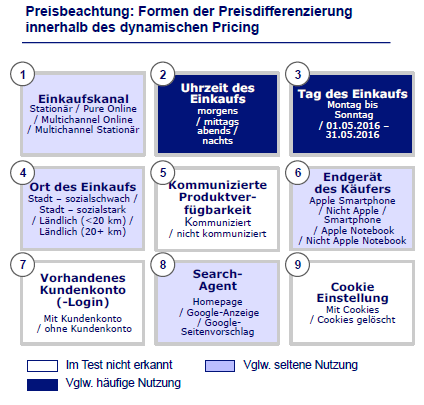Dynamic Pricing: Wonder Weapon or Customer Scare?
- adojo GmbH
Dynamic Pricing – a trendy buzzword that frequently appears in the context of Big Data and e-commerce. Just hearing this word, one can almost see the fear-contorted faces and raised fingers of consumer advocates. A brief search confirms what one might suspect: Dynamic Pricing is evidently the pinnacle of the malicious outgrowth of Big Data. The transparent customer reveals all their personal data and, as a reward, receives a price that matches their individual maximum willingness to pay. That’s how it works, right?
 Source: Krämer, A., Kalka, R., & Ziehe, N. (2016). Personalisiertes und dynamisches Pricing aus Einzelhandels- und Verbrauchersicht. Marketing Review St. Gallen, S. 5
The results show that overall, price fluctuations were detected in only about ¼ of the examined products. For 3 out of 4 products, the displayed prices remained unchanged during the observation period. Price changes were particularly noticeable in relation to days of the week and time of day. However, no indications of individual price determination based on a customer account or cookie settings were found in any provider. The results show that the majority of providers do not or only weakly implement dynamic price changes. Experts even explicitly warn against strongly discriminatory and opaque prices.
Source: Krämer, A., Kalka, R., & Ziehe, N. (2016). Personalisiertes und dynamisches Pricing aus Einzelhandels- und Verbrauchersicht. Marketing Review St. Gallen, S. 5
The results show that overall, price fluctuations were detected in only about ¼ of the examined products. For 3 out of 4 products, the displayed prices remained unchanged during the observation period. Price changes were particularly noticeable in relation to days of the week and time of day. However, no indications of individual price determination based on a customer account or cookie settings were found in any provider. The results show that the majority of providers do not or only weakly implement dynamic price changes. Experts even explicitly warn against strongly discriminatory and opaque prices.
But what exactly is Dynamic Pricing?
Dynamic pricing originated in the 1970s with the deregulation of the American air travel industry. Due to the new, strong competition from low-cost carriers, established airlines were put under pressure and resorted to price differentiation – with resounding success. This phenomenon quickly spread to other industries, so it is now common practice, especially in the travel and tourism sector. But dynamic pricing is also interesting for online shops. For instance, when it became known that Amazon changed the prices of certain products several times a day during the Christmas season, it caused a significant stir, even outside the industry. Dynamic pricing describes the pricing strategy where the price of a good is adjusted over time, depending on various market-dependent information. The basic rule is as simple as it is ingenious: when wealthy customer clientele is expected, prices are increased. Conversely, if weak demand is anticipated, prices are lowered. A classic example is price adjustment based on the weather. In the case of rain, higher willingness to pay for products like umbrellas is assumed, and consequently, the prices for these products are increased. In dynamic pricing, prices are adjusted based on the aggregated demand in the overall market. This means that for price calculation in dynamic pricing, theoretically only situational information like time of day, weather, or competitive prices are included. Thus, dynamic pricing can be classified as a form of third-degree price differentiation. Third-degree price differentiation occurs when different groups of people pay different prices for the same good. A classic example is student discounts at swimming pools. It is important, however, that people cannot or can only switch their segment with considerable effort. Source: Krämer, A., Kalka, R., & Ziehe, N. (2016). Personalisiertes und dynamisches Pricing aus Einzelhandels- und Verbrauchersicht. Marketing Review St. Gallen, S. 3
Source: Krämer, A., Kalka, R., & Ziehe, N. (2016). Personalisiertes und dynamisches Pricing aus Einzelhandels- und Verbrauchersicht. Marketing Review St. Gallen, S. 3
The fear of personalized prices is unfounded
Before anyone raises their voice in anger: don’t panic! Personalized prices, in particular, are much less widespread in practice than the media suggests. In a 2016 study, price fluctuations of 200 different consumer products from online and brick-and-mortar retail were observed over a period of 4 weeks (excluding tourism). Source: Krämer, A., Kalka, R., & Ziehe, N. (2016). Personalisiertes und dynamisches Pricing aus Einzelhandels- und Verbrauchersicht. Marketing Review St. Gallen, S. 5
The results show that overall, price fluctuations were detected in only about ¼ of the examined products. For 3 out of 4 products, the displayed prices remained unchanged during the observation period. Price changes were particularly noticeable in relation to days of the week and time of day. However, no indications of individual price determination based on a customer account or cookie settings were found in any provider. The results show that the majority of providers do not or only weakly implement dynamic price changes. Experts even explicitly warn against strongly discriminatory and opaque prices.
Source: Krämer, A., Kalka, R., & Ziehe, N. (2016). Personalisiertes und dynamisches Pricing aus Einzelhandels- und Verbrauchersicht. Marketing Review St. Gallen, S. 5
The results show that overall, price fluctuations were detected in only about ¼ of the examined products. For 3 out of 4 products, the displayed prices remained unchanged during the observation period. Price changes were particularly noticeable in relation to days of the week and time of day. However, no indications of individual price determination based on a customer account or cookie settings were found in any provider. The results show that the majority of providers do not or only weakly implement dynamic price changes. Experts even explicitly warn against strongly discriminatory and opaque prices.
Conclusion
Retailers are walking a tightrope with dynamic pricing. On one side is the enormous sales potential, on the other side is the risk of angering consumers with excessive price discrimination. Summarizing the results, one concludes that dynamic pricing is a very effective pricing strategy, from which consumers and retailers often benefit equally. However, perceived price fairness is an important risk factor. Therefore, a very sensitive approach to this topic is required.What can retailers do?
If you are considering using a dynamic pricing strategy for your online shop, then consider the following five points:- Ensure that the Dynamic Pricing System is efficiently integrated into the online shop and that processes and organization within the shop are adapted to it.
- The Data you collect is the basis for successful dynamic pricing. Make sure this data is always up-to-date and available in sufficient quantity. The more, the better!
- Avoid using personalized prices and instead rely on classic dynamic pricing or personalized discounts and coupons.
- One of a retailer’s most important assets is customer trust. Do not jeopardize this trust with opaque and highly discriminatory pricing strategies. Clear and honest communication with consumers should be the priority!
